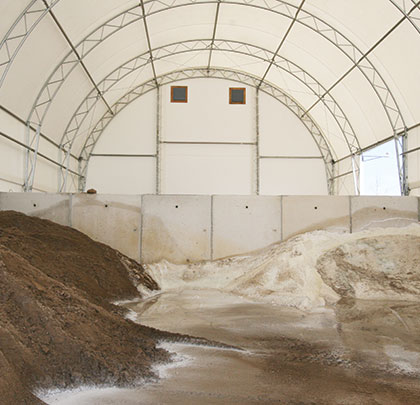For industry contractors, your company’s vehicles and equipment are major investments. And the buildings you store these assets in are equally important. And what building should you choose? What building will act as a warehouse, provide vehicle and equipment storage, and even provide offices or change rooms for workers? A fabric covered building, of course.
When deciding between a conventional-style building and more innovative solutions like fabric covered buildings, there are some important questions that should be asked. How much will they cost? What about customization or special requirements? How fast can they be constructed? With a conventional building, costs can rapidly increase when asking these questions and the timeline of the project is generally lengthy. Fabric covered buildings, on the other hand, have been designed for the contractor and construction industries, and their building needs.
THOUGHTS FROM HOGERVORST
Ben Hogervorst, president of Britespan Building Systems Inc., shares exactly what makes a fabric covered building the best building solution for the industry.
The first and most important challenge that choosing a fabric covered building addresses is vehicle and equipment storage. “It is crucial that your vehicles and equipment are stored in a clean, dry, and well-ventilated area. Look at the building you chose as an important contributing factor in preventive maintenance,” says Hogervorst. By storing your vehicles and equipment correctly, you ensure they are in prime operating condition at all times. “Because of the clear-span design, Britespan fabric covered buildings provide superior ventilation and air quality, reducing moisture and condensation, and minimizing the risk of rust and ceased parts,” he says.
That clear-span design also provides ample height and extraordinary clearance for access, ease of movement, and loading and handling with heavy equipment and machinery. There are no internal columns to interfere with bays, trucks, or heavy machinery, optimizing the entire cubic space. Choosing a fabric covered building means your business can gain the benefits of increased storage space or operational manufacturing space sooner, as they are often delivered and constructed in less time than conventional buildings.

The City of Orillia constructed a 40 ft by 100 ft fabric building for salt storage.
DURABILITY TESTED
What about durability? Unlike conventional buildings, Britespan fabric buildings have tested ability to withstand corrosive materials and environments, ideal for salt and sand storage, for example. “A key differentiator between a fabric building from Britespan and other suppliers is that we hot dip galvanize our trusses and truss components after all welding and fabrication has been completed. What this does is creates a coating that is bonded to the steel, and lifelong corrosion protection, whereas companies that hot dip galvanize before fabrication leave areas of the truss where the galvanizing has been burnt off, and the trusses will likely rust form the inside out,” says Hogervorst. For contractor and construction companies, this is a major benefit and assurance of the buildings quality and how long they will last.
FABRIC BENEFITS
The translucent properties of Britespan’s fabric covers allow natural daylight into the building, reducing or eliminating daytime lighting costs, and creating a safe and shadow-free environment for workers. Unlike conventional construction, where the outer covering is often punctured thousands of times to attach the roofing and wall cladding, our clear-span steel frame buildings are 500 percent more airtight, reducing air and heat loss.
The fabric cover has non-conductive properties that reduce the transmission of heat and cold, making the building feel warmer on cold days and cooler on hot summer days. Traditional construction simply cannot match these advantages without substantial costly upgrades.
“Today’s fabric buildings truly are designed for contractors and construction companies,” says Hogervorst, “the possibilities of what they can be used for are endless. Ask yourself what you would need a building for, and I can guarantee a fabric covered building would meet and exceed those needs or requirements,” he says. In addition to vehicle and equipment storage, they act as perfect warehouses and storage facilities for material and have flexible foundation and door options to meet all needs and requirements. The possibilities are truly endless.
OPTIONS FOR CUSTOMIZATION
Door options can vary from roll up doors, steel doors, accordion style, bi-fold doors, slider doors, etc., and can be designed on either the end or side walls of a building. Foundation options vary from steel legs, precast walls, poured concrete, and even sea cans. The sea can foundations allow for complete utilization of the building, as they can also act as offices, staff lunch rooms, and change rooms.
When you are thinking about the right building to purchase for your contracting or construction company, or even replacing an old one, choosing a fabric covered building from Britespan Building Systems helps you know you made the right choice, in a long lasting, durable, and customizable building that will never stop working for you. ■
For More Information
For more information about fabric buildings and the solutions they provide, contact Britespan Building Systems Inc., at 800.407.5846, or visit www.britespanbuildings.com.
Modern Contractor Solutions, January 2015
Did you enjoy this article?
Subscribe to the FREE Digital Edition of Modern Contractor Solutions Magazine!


